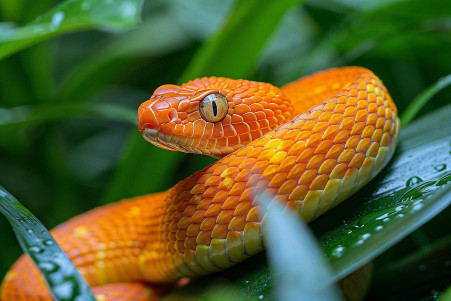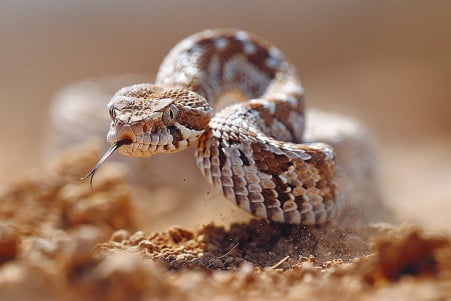Did Snakes Have Legs? Tracing Their Evolutionary History
21 February 2024 • Updated 20 February 2024

While snakes move with ease today, could their ancestors have once used legs to walk? Modern snakes are legless and completely adapted to a life without limbs. Yet, snakes evolved from animals with legs, and they have left behind vestigial structures and genetic evidence that show they once had legs.
In this article, we will review the evolutionary biology, paleontological, and genetic research that has been done to explain how today’s legless snakes evolved from legged ancestors. We will also look at the evidence of vestigial structures and the molecular biology of limb development to piece together the story of snake evolution.
Let’s take a look at the evidence and see if we can figure out how snakes went from ancient legged ancestors to the legless, slithering creatures we know today.
Did snakes have legs?
The Sonic Hedgehog Gene and the Evolution of Snake Limbs
The Sonic hedgehog gene is a master regulator of limb development in vertebrates and plays a key role in the development of arms and legs in the embryo.
In snakes, mutations in a critical enhancer of this gene have reduced the gene’s activity to a fraction of its original level. According to National Geographic, these mutations have prevented the gene from activating the full development of limbs, as it does in other reptiles like lizards, and have been a driving force in the evolutionary loss of snake limbs.
A study in Current Biology found that python embryos go through a short period of limb development, indicating that snakes have a legged ancestor. Even though snakes have lost their limbs as adults, pythons still have the HOXD digit enhancers, which are responsible for the development of fingers and toes.
This suggests that the potential for limb development in snakes has not been completely lost during evolution. The fact that these genetic elements have been retained is a fascinating example of the complexity of snake evolution, where the loss of a trait like limbs still leaves a genetic legacy.
These genetic discoveries open the door to a deeper understanding of the evolutionary history of snakes through the physical evidence of their past, including vestigial bones.
Vestigial Evidence: Snakes and Their Legged Ancestors
Deep inside the powerful lower bodies of pythons and boa constrictors, vestigial pelvic spurs and femur rudiments are the last remaining evidence of the snakes’ shared ancestry with legged lizards.
According to the American Museum of Natural History, the pelvic spurs and femur rudiments are important proof that snakes evolved from lizard ancestors, and they are the best examples of vestigial structures. More than 100 million years ago, lizards with shorter legs were the most successful, leading to the evolution of lineages that eventually lost their legs entirely, a process that is documented in the vestigial legs of the reticulated python.
Vestigial structures provide a physical record of snake evolution and their transition from legged reptiles to the legless serpents we know today. Wikipedia explains that pelvic spurs are especially important because they are the remnants of a functional femur in ancestors with fully formed limbs. While snakes no longer use them for movement, males have found a new purpose for them in their courtship and mating rituals.
These vestigial structures are a clear example of how snakes have changed over time. Even though they are no longer used for their original purpose, they are a reminder of the snakes’ legged past and help scientists understand how these reptiles adapted to life without legs.
Fossil Records: Discovering the Evolution of Snakes
Fossil records are the history books of the Earth, chronicling the rise and fall of species over millions of years. One of the most important entries in these records is the 90-million-year-old snake fossils found in Argentina, which have helped to uncover the evolutionary past of snakes.
According to Science Advances, the fossils, which belong to the extinct snake group Najash, are the only known snake fossils to have hind legs. This has led researchers to believe that snakes lost their front legs before their back legs, a theory that contradicts what was previously known about the evolution of snakes.
The importance of these fossils has been further solidified by the discovery of the MPCA 500 skull, which is a landmark in the study of ancient snake anatomy. According to The New York Times, the skull of this Mesozoic snake is one of the most complete ever found and has provided an important anatomical reference point that has helped to connect ancient snakes to their modern ancestors.
Still, the evolutionary history of snakes is filled with controversy, especially when it comes to the classification of Tetrapodophis amplectus. As reported by Nature, the discovery of this four-legged fossil snake has led to a great deal of controversy because of its combination of snake-like features and appendages, which some researchers believe were used for grasping prey or mates rather than locomotion.
By wading through these controversies and examining the impact of legged snake fossils, we can better understand how snake locomotion has evolved. This evolution is evidence of the genetic and vestigial records of snakes and the incredible ways they have adapted to move without the limbs their ancestors once had.
Mastering Movement: The Physics of Snake Locomotion
Snakes have evolved a wide range of movement patterns to make up for their lack of legs. A paper in PubMed by Bruce C. Jayne explains that snake locomotion goes beyond the four basic modes—rectilinear, lateral undulation, sidewinding, and concertina—and is influenced by the environment and the specific task at hand. For example, the muscle activity and body bending of snakes moving in water and snakes moving in trees are different.
Research on sidewinding by Jessica Tingle shows that snakes have evolved a number of specialized ways of moving to help them survive in different environments, including adaptations that help them move efficiently across desert sand.
The skin and scales of snakes are essential to these movements, providing the friction and traction that snakes need to move without legs. A paper in the Journal of Experimental Biology goes into great detail about the biomechanics of snake locomotion, with an emphasis on the importance of the axial musculature and the vertebral column.
Snakes have evolved a body plan that is both highly adaptable and highly efficient, allowing them to meet the many challenges of their environment and move in a way that is highly effective. This elegant solution to the problem of moving without legs is a great example of the dynamic and flexible nature of evolution and shows how snakes have managed to conquer the land, the trees, and the water.
The Evolutionary Story Unraveled: From Ancient Legs to Modern Slithers
In wrapping up our discussion of the evolutionary history of snakes, it is evident that there is a clear lineage from limbed animals to the limbless wonders of today.
Genetic studies, including the discovery of the Sonic hedgehog gene and the conservation of HOXD digit enhancers, are essential to understanding this transition.
Meanwhile, the vestigial nature of the tiny leg bones in pythons and the pelvic spurs in boas provide a direct connection to their legged ancestors. Fossil evidence, including the groundbreaking discovery of Najash and its legs and the MPCA 500 skull, show the progression of this evolution and provide a glimpse into the past.
The investigation of snake locomotion demonstrates how these animals have adapted to move in a variety of ways without the use of limbs. This adaptation is a clear indication of the ever-changing nature of evolution, in which the need to survive leads to the ability to thrive.
By bringing these pieces of evidence together, this article shows how readers can better understand the anatomy and evolution of snakes. In understanding the past, we can better understand the present and the complex network of life that is still evolving today.


